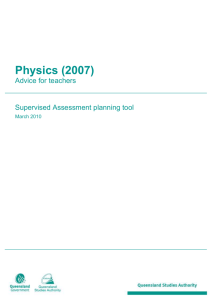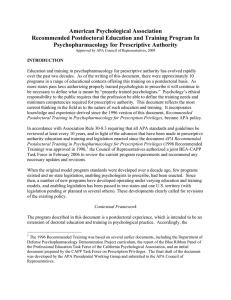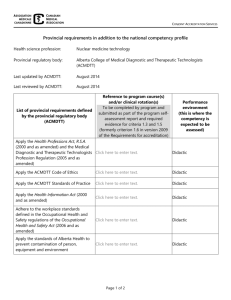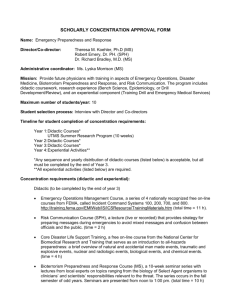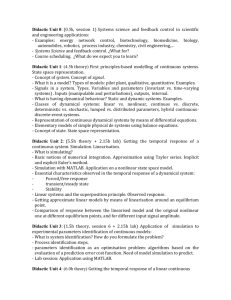American Psychological Association
advertisement
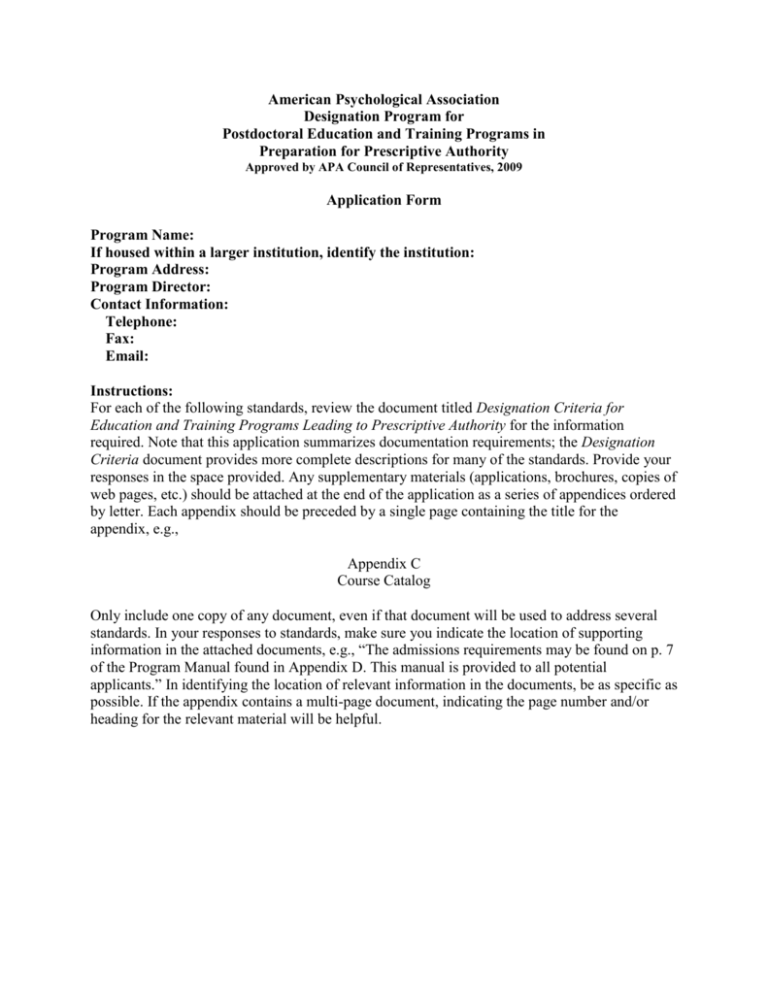
American Psychological Association Designation Program for Postdoctoral Education and Training Programs in Preparation for Prescriptive Authority Approved by APA Council of Representatives, 2009 Application Form Program Name: If housed within a larger institution, identify the institution: Program Address: Program Director: Contact Information: Telephone: Fax: Email: Instructions: For each of the following standards, review the document titled Designation Criteria for Education and Training Programs Leading to Prescriptive Authority for the information required. Note that this application summarizes documentation requirements; the Designation Criteria document provides more complete descriptions for many of the standards. Provide your responses in the space provided. Any supplementary materials (applications, brochures, copies of web pages, etc.) should be attached at the end of the application as a series of appendices ordered by letter. Each appendix should be preceded by a single page containing the title for the appendix, e.g., Appendix C Course Catalog Only include one copy of any document, even if that document will be used to address several standards. In your responses to standards, make sure you indicate the location of supporting information in the attached documents, e.g., “The admissions requirements may be found on p. 7 of the Program Manual found in Appendix D. This manual is provided to all potential applicants.” In identifying the location of relevant information in the documents, be as specific as possible. If the appendix contains a multi-page document, indicating the page number and/or heading for the relevant material will be helpful. Criterion P: Program (P) Characteristics P1. Admissions 1. Submit materials used to inform potential applicants of admission requirements. 2. Submit application forms verifying compliance with requirements. 3. Do you accept applicants not meeting the stated requirements? Yes No If yes, please explain Over the last three years, what percent of your admissions were exceptions? 2 P2. Transfer of Credit 1. Does your program accept transfer credit? Yes No If yes, describe your policies for accepting transfer credit. This should include courses in your curriculum for which you accept transfer credit and the maximum percent of your curriculum for which you allow transfer credit. 2. If you allow advanced placement based on prior postdoctoral education and training, provide us with your program policy for establishing competency and currency of knowledge base. 3 P3. Ethical Standards 1. Describe how the current Ethical Principles of Psychologists and Code of Conduct of the American Psychological Association is made available to faculty members and administrators who are psychologists. 2. Provide a copy of program policies indicating that students will be treated in a fair and ethical manner consistent with the current Ethical Principles of Psychologists and Code of Conduct of the American Psychological Association. 4 P4. Public Representation of the Program 1. Attach a copy of your current mission statement. 2. Indicate how this mission statement is communicated to the public. 3. Provide copies of public materials indicating the program is a postdoctoral program for psychologists in psychopharmacology for prescriptive authority. 5 P5. Program Resources 1. Describe resources for delivery of education and training materials. 2. Describe all additional resources available to students. 3. Provide evidence to suggest that sufficient financial resources exist to ensure the program will be sustainable at least for the duration of the current student body. 6 P6. Governance 1. Describe your program’s governance structure and provide a copy of the organizational chart, as well as copies of the job description and curriculum vitae for program administrators. 2. Provide materials or otherwise describe the mechanism(s) by which faculty is informed of their rights and program policies. 3. Describe your program’s grievance and due process procedures that are available for faculty. 7 P7. Faculty 1. Provide the name and current curriculum vitae for primary instructors in each program module. 2. Provide evidence of licensure in good standing (if applicable) for each faculty member and clinical supervisor. 8 P8. Quality Assurance 1. Describe current consortial arrangements or contractual agreements. 2. Describe mechanisms used to ensure the quality of education training offered through those agreements. 3. Provide evidence of licensure in good standing (if applicable) for each faculty member and clinical supervisor. 9 P9. Program Self-Evaluation 1. Describe procedures for program self-evaluation. 2. Describe how you maintain currency of course materials. 3. Provide evidence of licensure in good standing (if applicable) for each faculty member and clinical supervisor. 10 Criterion S: Students (S) S1. Student Body 1. How do you define an active student in your program? 2. Please fill in the following information: Program Training Model Didactic combined with supervised clinical experience Number of Students Currently Enrolled Number of Students who Completed in the past 3 years 3. Please describe the diversity of your student body. 11 Didactic followed by summative clinical experience Didactic Supervised Clinical Experience S2. Maintenance of Licensure 1. Describe how students are informed they are expected to remain licensed for the course of the program and to indicate changes in licensure status. 2. Are students required to provide evidence of continued licensure? Yes No If yes, how is this evidence collected? 12 S3. Student Records 1. Describe methods used to ensure the security and maintenance of student records stored in either paper or electronic form. 2. Describe the mechanisms used to assure the long-term maintenance of student records. 3. Provide a sample of a transcript or official documentation that confirms successful completion of program requirements. 4. Provide a sample of the certificate of completion of all program components (didactic, supervised clinical experience, and capstone competency evaluation). 13 S4. Due Process 1. Provide materials or otherwise describe the mechanism(s) by which students are informed of their rights and program policies. 2. Describe grievance and due process procedures available for students in the program. 14 Criterion C: Curriculum (C) C1. Didactic Curriculum 1. Provide a current syllabus for each course or course module. This syllabus should, at a minimum, include a description of expected student learning outcomes for each course or course module and how student performance is assessed. 2. Provide the curriculum vitae of each instructor for each course or course module. 3. Create a grid that indicates the number of hours in each course dedicated to each of the content domains required for the program. A template for the grid is attached. 15 Different programs share content but organize the curriculum in different ways and use different course titles. For each course in your program, indicate the number of contact hours associated with each content domain reflected in the model curriculum. Course or Course Module: Identify courses below the grid (e.g., “1 = Clinical Medicine”) Add more columns if you have more than 10 courses or modules. Content Mapping Chart 1 2 3 4 5 6 7 8 9 10 I. Basic Science A. Anatomy & Physiology B. Biochemistry II. Neurosciences A. Neuroanatomy B. Neurophysiology C. Neurochemistry III. Physical Assessment/Labs A. Physical Assessment B. Lab and Radiological Assessment C. Medical Terminology IV. Clinical Medicine/Pathophysiology A. Pathophysiology B. Clinical Medicine C. Differential Diagnosis D. Clinical Correlations E. Substance-Related Disorders F. Chronic Pain Management V. Pharmacology and Psychopharmacology A. Pharmacology B. Clinical Pharmacology C. Pharmacogenetics D. Psychopharmacology E. Developmental Psychopharmacology 16 Content Mapping Chart F. Diversity VI. Clinical Pharmacotherapeutics A. Combined Therapies B. Computer Aids C. Pharmacoepidemiology VII. Research A. Methodology and Design B. Interpretation of Research C. Regulatory Processes VIII. Professional, Ethical, and Legal Issues A. Existing Laws and Standards B. Pharmaceutical Industry 1. Conflict of Interest 2. Marketing Practices 3. Critical Consumer Course or Course Module: Identify courses below the grid (e.g., “1 = Clinical Medicine”) Add more columns if you have more than 10 courses or modules. 1 2 3 4 5 6 7 8 9 10 17 C2. Supervised Clinical Experience 1. Please complete the following grid if your program integrates supervised clinical experiences with didactic experiences: Please note with an (X) which of the 8 clinical competencies are integrated within each of the didactic courses listed below. Your list of courses should match your content mapping chart. Course 1 Course 2 Course 3 Course 4 Course 5 Course 6 Course 7 Course 8 Course 9 Course 10 1 2 3 4 5 6 7 8 2. Describe in detail how your program implements the supervised clinical component of the training. 3. Provide copies of all materials used by the program to evaluate student performance in the completion of the supervised clinical experience. 4. Provides copies of forms used by the student and the supervisor to document students’ faceto-face patient contact hours and other clinical experiences. 18 C3. Capstone Competency Evaluation 1. Describe in detail your program’s capstone evaluation process, including how outcome is determined. 2. In each of the last three years, how many students have participated in the capstone competency evaluation? How many in each year have passed? 19 C4. Certification of Completion 1. Some programs elect to provide some form of recognition upon completion of didactic coursework even if the supervised clinical experience is not yet completed. Does your program offer this option? Yes No If yes, indicate what form this recognition takes (certificate, master’s degree, etc.) 2. What form of recognition do you give for completion of all program components? Please submit a sample copy. 3. Your program may not represent students as having completed the APA Recommended Postdoctoral Education and Training Program in Psychopharmacology for Prescriptive Authority until such time as they have completed the didactic, supervised clinical experience, and capstone components of the program. We are compliant with this: Yes No 20 C5. Lifelong Learning 1. Please describe how your program prepares students for lifelong learning. 21

